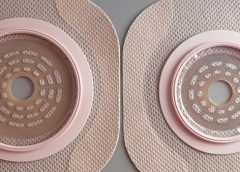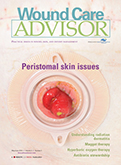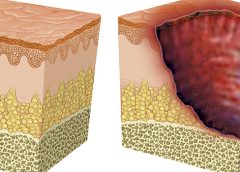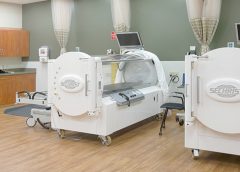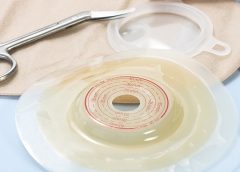As full-thickness wounds heal, they begin to fill in from the bottom upward with granulation tissue. At the same time, wound edges contract and pull together, with movement of epithelial tissue toward the center of the wound (contraction). These epithelial cells, arising from either the wound margins or residual dermal epithelial appendages within the wound bed, begin to migrate in leapfrog or train fashion across the wound bed. Horizontal movement stops when cells meet (contact inhibition). The ideal wound edge is attached to and flush with the wound bed, moist and open with the epithelial rim thin, and pale pink to translucent. (more…)
Read MoreSearch Results for: trac
How to manage peristomal skin problems
For an ostomy pouching system to adhere properly, the skin around the stoma must be dry and intact. Otherwise, peristomal skin problems and skin breakdown around the stoma may occur. In fact, these problems are the most common complications of surgical stomas. They can worsen the patient’s pain and discomfort, diminish quality of life, delay rehabilitation, increase use of ostomy supplies, and raise healthcare costs.
Peristomal skin problems also perpetuate a vicious cycle in ostomy patients: They impair adhesion of the pouching system, which in turn exacerbates the skin problem. That’s why maintaining peristomal skin integrity and addressing skin problems promptly are so crucial. (more…)
Read MoreClinical Notes: Moldable Skin Barrier, hypoglycemia, diabetic food ulcers
Moldable skin barrier effective for elderly patients with ostomy
A study in Gastroenterology Nursing reports that compared to a conventional skin barrier, a moldable skin barrier significantly improves self-care satisfaction scores in elderly patients who have a stoma. The moldable skin barrier also caused less irritant dermatitis and the costs for leakage-proof cream were lower.
“The application of a moldable skin barrier in the self-care of elderly ostomy patients” included 104 patients ages 65 to 79 who had a colostomy because of colorectal cancer.
Risk factors for severe hypoglycemia in older adults with diabetes identified
Read More2016 Journal: May – June Vol. 5 No. 3
Privacy Policy
We may use the information we collect from you when you register, make a purchase, sign up for our newsletter, respond to a survey or marketing communication, surf the website, or use certain other site features in the following ways:
Our website is scanned on a regular basis for security holes and known vulnerabilities in order to make your visit to our site as safe as possible.
We use regular Malware Scanning.
We do not sell, trade, or otherwise transfer to outside parties your Personally Identifiable Information unless we provide users with advance notice. This does not include website hosting partners and other parties who assist us in operating our website, conducting our business, or serving our users, so long as those parties agree to keep this information confidential. We may also release information when it’s release is appropriate to comply with the law, enforce our site policies, or protect ours or others’ rights, property or safety.
However, non-personally identifiable visitor information may be provided to other parties for marketing, advertising, or other uses.
Google’s advertising requirements can be summed up by Google’s Advertising Principles. They are put in place to provide a positive experience for users. https://support.google.com/adwordspolicy/answer/1316548?hl=en
Users can set preferences for how Google advertises to you using the Google Ad Settings page. Alternatively, you can opt out by visiting the Network Advertising Initiative Opt Out page or by using the Google Analytics Opt Out Browser add on.
When it comes to the collection of personal information from children under the age of 13 years old, the Children’s Online Privacy Protection Act (COPPA) puts parents in control. The Federal Trade Commission, United States’ consumer protection agency, enforces the COPPA Rule, which spells out what operators of websites and online services must do to protect children’s privacy and safety online.
The Fair Information Practices Principles form the backbone of privacy law in the United States and the concepts they include have played a significant role in the development of data protection laws around the globe. Understanding the Fair Information Practice Principles and how they should be implemented is critical to comply with the various privacy laws that protect personal information.
The CAN-SPAM Act is a law that sets the rules for commercial email, establishes requirements for commercial messages, gives recipients the right to have emails stopped from being sent to them, and spells out tough penalties for violations.
If at any time you would like to unsubscribe from receiving future emails, you can email us at
and we will promptly remove you from ALL correspondence.
If there are any questions regarding this privacy policy, you may contact us using the information below.
Doylestown, PA 18901
Exercise your right to be fit!
Nearly all clinicians know exercise is good for our physical and mental health. But incorporating it into our busy lives can be a challenge. The only types of exercise some clinicians have time for are working long shifts, juggling life’s demands, balancing the books, jumping on the bandwagon, climbing the ladder of success, and skipping meals.
Clinicians are in a unique position to help patients change their behavior to improve their health. Ironically, the first behavior clinicians need to change is to work toward improving our own exercise habits. (more…)
Read MoreNutritional considerations in patients with pressure ulcers
Optimizing nutritional status is a key strategy both in preventing and managing pressure ulcers. In patients across all care settings, compromised nutrition— as from poor intake, undesired weight loss, and malnutrition—increases the risk of pressure ulcers. It contributes to altered immune function, impaired collagen synthesis, and decreased tensile strength. In many cases, malnutrition also contributes to wound chronicity and increases the risk for delayed and impaired wound healing. In patients with chronic wounds, such as pressure ulcers, a chronic inflammatory state can induce catabolic metabolism, malnutrition, and dehydration. (more…)
Read MoreClinical Notes: ostomy, pressure ulcer, burn treatment
Self-management ostomy program improves HRQOL
A five-session ostomy self-care program with a curriculum based on the Chronic Care Model can improve health-related quality of life (HRQOL), according to a study in Psycho-Oncology.
“A chronic care ostomy self-management program for cancer survivors” describes results from a longitudinal pilot study of 38 people. Participants reported sustained improvements in patient activation, self-efficacy, total HRQOL, and physical and social well-being. Most patients had a history of rectal cancer (60.5%) or bladder cancer (28.9%). (more…)
Read MoreBuzz Report: Latest trends, part 2
Keeping clinicians up-to-date on clinical knowledge is one of the main goals of the Wild on Wounds (WOW) conference held each September in Las Vegas. Every year, I present the opening session, called “The Buzz Report,” which focuses on the latest-breaking wound care news—what’s new, what’s now, and what’s coming up. I discuss new products, practice guidelines, resources, and tools from the last 12 months in skin, wound, and ostomy management.
In the January issue, I discussed some of the updates from my 2015 Buzz Report. Now I’d like to share a few more, along with some of my favorite resources. (more…)
Read MoreTop 10 outpatient reimbursement questions
At the 2015 Wild on Wounds conference, the interactive workshop “Are You Ready for an Outpatient Reimbursement Challenge?” featured a lively discussion among participants about 25 real-life reimbursement scenarios. Here are the top 10 questions the attendees asked, with the answers I provided.
Q Why is it necessary for qualified healthcare professionals (QHPs) such as physicians, podiatrists, nurse practitioners, physician assistants, and clinical nurse specialists to identify the place of service where they provide wound care services and to correctly state the place of service on their claim forms? (more…)
Read MoreClincal Notes: Analysis, Osteomyelitis, sickle cell, maggot
Value of systematic reviews and meta-analyses in wound care
“Systematic reviews and meta-analyses—literature-based recommendations for evaluating strengths, weaknesses, and clinical value,” in Ostomy Wound Management, discusses evidence-based practice and how systematic reviews (SRs) and meta-analyses (MAs) can help improve management of wound care patients.
The authors of the article explain evidence-based practice and provide useful definitions for key terms. They then provide a list of eight questions to use when evaluating SRs and practical tips such as how to search for SR and MA studies. The article finishes with a list of eight interventions supported by the most evidence: hydrocolloidal dressings, honey, biosynthetic dressings, iodine complexes, silver compounds, hydrogels, foam dressings, and negative pressure wound therapy. (more…)
Read MoreClinician Resources: Ulcer Prevention, CAUTI, Negative Bacteria
Start the New Year off right by checking out these resources.
Pressure ulcer prevention education
Access the following education resources from Wounds International:
The webinar “Real-world solutions for pressure ulcer prevention: Optimising the role of support surfaces” includes:
• an overview of the issue of pressure ulcers
• what to consider when choosing a support surface
• how to operationalize support surfaces in the clinical setting. (more…)
Read More

